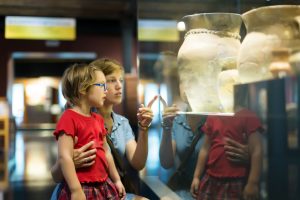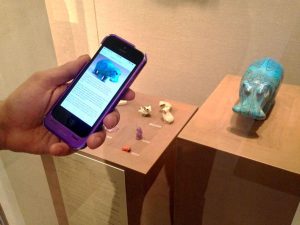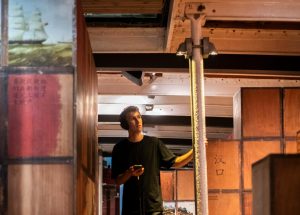For my blog I wanted to explore different ways museums have adapted their processes to create hyperlinked environments.

Note. From How Does Learning Happen in Museums? [photo of museum visitors looking at an exhibit], The University of Melbourne; Pursuit. https://pursuit.unimelb.edu.au/articles/how-does-learning-happen-in-museums
According to the Melbourne Museum, learning in museums is typically an autonomous or self-regulated experience where each visitor takes on an active role in planning, monitoring, controlling, and reflecting (Oliveria & Barba, 2018). They found that highly engaged patrons visited more exhibits, interacted more with exhibition content, and had higher levels of perceived learning and interest development compared to less engaged visitors (Oliveria & Barba, 2018). Their findings suggest that the more engaged patrons are during their visit the more they learn and develop interest for museum exhibitions.

Note: From Beacons: Exploring location-based technology in museums [members of the MediaLab explore the galleries of Egyptian art using beacon technology. Photo by Don Undeen], 2015, The Met. https://www.metmuseum.org/perspectives/beacons
Some museums like the Metropolitan Museum of Art (MOMA) have turned to iBeacon technology to increase visitor engagement. It allows museum visitors to learn more about exhibits and collections via a mobile phone application that provides audio/video content and descriptions of objects as they make their way through the museum (Doljenkova & Tung, 2015). A trial run found that the battery life of the iBeacon broadcasting units depleted faster in certain conditions and signal interferences occurred in exhibits with increased foot traffic (Doljenkova & Tung, 2015). Despite these challenges, iBeacon technology has been applied effectively in some institutions like the Cutty Sark Maritime Museum.

Note. From Immersive Soundscapes on the Cutty Sark: Blending Technology and Heritage [photograph of young man with headphones walking through the Cutty Sark in Greenwich], 2024, MuseumNext. https://www.museumnext.com/article/immersive-soundscapes-on-the-cutty-sark-blending-technology-and-heritage/
In partnership with Thanoos Kokkiniotis, the CEO of Smartify, the Sark Maritime Museum created an immersive soundscape using iBeacon technology and the Smartify application (Charr, 2024). It not only replicated the sounds of the ship’s golden age, it also included original compositions to invoke emotional connections with patrons as they navigated different exhibits (Charr, 2024). Applying this technology to their museum environment not only increased visitor engagement, but also aligned with the ship’s preservation requirements and was cost effective.
Although new technologies can be great tools to enhance patrons’ experiences, it alone cannot sustain a hyperlinked institution or environment. To create hyperlinked institutions with thriving hyperlinked environments we must assess the needs and interests of our patrons, collaborate with key stakeholders, and not be afraid to invest in new technologies to enhance patron’s experiences at our institutions.
References:
Charr, M. (2024). Immersive Soundscapes on the Cutty Sark: Blending Technology and Heritage. MuseumNext. https://www.museumnext.com/article/immersive-soundscapes-on-the-cutty-sark-blending-technology-and-heritage/
Doljenkova, V. & Tung, G. (2015). Beacons: Exploring location-based technology in museums. The Met. https://www.metmuseum.org/perspectives/beacons
Oliveira, E. A. & Barba, P. D. (2018). How Does Learning Happen in Museums?: Bluetooth technology has helped reveal how visitors explore museum exhibitions, and how much they learn in the process. Pursuit; The University of Melbourne. https://pursuit.unimelb.edu.au/articles/how-does-learning-happen-in-museums
Hi Daniel,
Great choice in topic for the reflection post! This post made me think about my prior experiences with museums — especially as a child, when I went to a ton of them on field trips in elementary school. (It’s crazy how I had so many opportunities then, when I feel like I’d appreciate it so much more now! But that’s beside the point.) It made me think about how one of my fondest museum field trips was to The Tech Interactive museum in San Jose. Though my memory of it is hazy now since it’s been so long, what really stood out to me then was the level of interaction that the museum provided. It had a ton of hands-on exhibits to help teach its concepts, which was extremely engaging and fun to me and many of my classmates. This feels like a perfect example of what you discussed in this post in action! And I have a hunch that many people across age groups would also enjoy features like this in more museums.